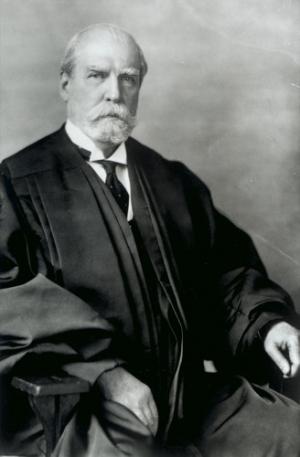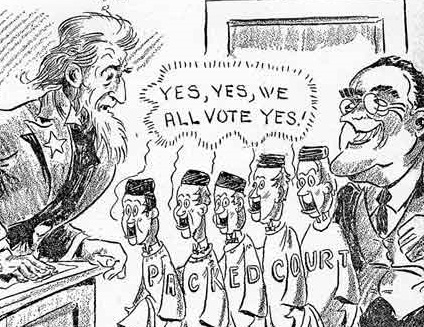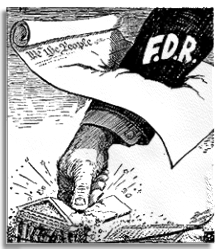Charles Evans Hughes, Sr. (1862 – 1948) was an American statesman, lawyer, and Republican politician from New York. He served as Governor of New York, Associate Justice of the Supreme Court of the United States, United States Secretary of State, a judge on the Court of International Justice, and the 11th Chief Justice of the United States (1930–1941).
Hughes graduated third in his class from Brown University at the age of 19, having been elected to Phi Beta Kappa in his junior year. He entered Columbia Law School in 1882, where he graduated in 1884 with highest honors. While studying law, he taught at Delaware Academy. He is said to have had a photographic memory and a great intellect.

Charles Evans Hughes, 1908
Early in his career, Hughes lectured at Cornell Law School, New York University Law School, and served as a special assistant to the U.S. Attorney General. Hughes was the Governor of New York from 1907 to 1910, defeating William Randolph Hearst in the 1906 election to gain the position.
In 1908, Hughes was offered the vice-presidential nomination by William Howard Taft, but he declined it to run again for Governor.
As the Governor, Hughes produced important reform legislation, helping to counter political corruption, extending the state’s regulatory authority, and expanding governmental police and welfare functions.

Gubernatorial portrait of Charles Evans Hughes
On this day in history, April 25, 1910, President William H. Taft nominated Hughes for Associate Justice of the Supreme Court to fill the vacancy left by the death of Justice David J. Brewer. The Senate confirmed the nomination on May 2, 1910, and Hughes served as associate justice of the Supreme Court from 1910 to 1916.
In 1916, Hughes resigned from the Court to accept the Republican nomination as its presidential candidate, to run against incumbent Woodrow Wilson.
After Hughes was defeated by Wilson, he returned to the practice of law. In 1921, he was appointed Secretary of State by President Warren G. Harding.
After leaving the State Department, he again rejoined his old partners at the Hughes law firm, and became one of the nation’s most sought-after advocates. From 1925 to 1930, for example, Hughes argued over 50 times before the U.S. Supreme Court. From 1926 to 1930, Hughes also served as a member of the Permanent Court of Arbitration and as a judge of the Permanent Court of International Justice in The Hague, Netherlands from 1928 to 1930.
Herbert Hoover, who had appointed Hughes’s son as Solicitor General in 1929, appointed Hughes Chief Justice of the United States on February 3, 1930. Hughes was confirmed by the United States Senate on February 13, 1930, and served in this capacity until 1941. Hughes replaced former President William Howard Taft, a fellow Republican who had also lost a presidential election to Woodrow Wilson (in 1912) and who, in 1910, had appointed Hughes to his first tenure on the Supreme Court.

Portrait of Hughes as Chief Justice.
Upon his return to the Supreme Court, Hughes was known as a centrist, who, however, was often aligned with the court’s three liberal Justices — Louis Brandeis, Harlan Fiske Stone, and Benjamin Cardozo. With them he took progressive stances, upholding legislation protecting civil rights and civil liberties, and writing the opinion for the Court in Near v. Minnesota (283 U.S. 697, 1931), a landmark decision that recognized the freedom of the press by rejecting prior restraints on publication, a principle that was applied to free speech generally in subsequent jurisprudence.
But President Franklin Roosevelt was growing increasingly unhappy with the Court, which struck down some of his efforts to push through several New Deal measures intended to bolster economic recovery during the Great Depression. He avoided a confrontation in the election year of 1936. After he won that election, however, he proceeded to introduce, on February 5, 1937 his so-called “Court packing” plan. In essence, he sought to counter the opposition to his programs by expanding the number of justices, in order to create a pro-New Deal majority on the bench. His Judiciary Reorganization Bill of 1937 would have granted the President power to appoint an additional justice to the U.S. Supreme Court for every sitting member over the age of 70½, up to a maximum of six.

McClure’s Magazine
The plan came under heavy attack, with Hughes working behind the scenes to help defeat it by rushing important New Deal legislation through the court and ensuring that the court’s majority would uphold their constitutionality. Perhaps the most important such case was West Coast Hotel v. Parrish (300 U.S. 379, 1937), in which a divided Court, with Hughes writing for the 5-4 majority, upheld the constitutionality of Washington state’s minimum wage law, and by implication, much more of the New Deal.
FDR’s court-packing legislation was presented to Congress on February 5, 1937. The West Coast Hotel ruling came several weeks after the legislation was presented to Congress, with Associate Justice Owen Roberts joining the more liberal wing of the bench. Justice Roberts had previously ruled against most New Deal legislation. Thus his switch here was widely seen by contemporaries as an effort to maintain the Court’s judicial independence by eliminating Roosevelt’s rationale for judicial reorganization. His move came to be known as “the switch in time that saved nine,” but Hughes and Roberts both later claimed that the Chief Justice had already convinced Roberts to change his method of voting months before Roosevelt announced his court-packing plan.
Ultimately, Roosevelt’s proposed court packing plan failed. The entire episode created a public relations nightmare for Roosevelt and also sapped his influence over Congress.

Los Angeles Times
Hughes wrote 199 majority opinions during his time as Chief Justice, from 1930 to 1941. He died on August 27, 1948, at the age of 86.




Leave a comment